Application Scope of Class A, B, and C Fire Doors in Buildings

The correct use of fire doors is critical in building fire protection. Today, most designers can select the appropriate fire door levels based on the size, function, floors, and locations of buildings. By installing fire doors where required, they help slow down fire spread, mitigate damage, and provide crucial time for firefighting. However, some designers still make mistakes in using fire doors, such as not using fire doors where needed or using lower-rated fire doors (e.g., Class B or Class C) where higher-rated ones (e.g., Class A) are required. Conversely, some locations unnecessarily install high-level fire doors, increasing costs for the users.
In this article, we summarize the relevant clauses from the Building Design Fire Code (GBJ16-87), Fire Code for High-Rise Civil Buildings (GB50045-95), and Fire Code for Car Garages and Parking Lots (GB50067-97), which outline the appropriate use of Class A, B, and C fire doors. As a leading China fire door manufacturer, we aim to provide you with detailed, standardized fire protection solutions.
1. Application Scope of Class A Fire Doors (Fire Resistance Rating of 1.2 hours or More)

Building Design Fire Code GBJ16-87:
- Evacuation doors installed in firewalls. (GBJ16-87-7.1.4)
- Exterior doors of buildings storing Category C liquid tanks. (GBJ16-87-3.2.1)
- Doors connecting boiler rooms or oil-immersed transformer rooms to other rooms within the main structure. (GBJ16-87-5.4.1)
Fire Code for High-Rise Civil Buildings GB50045-95:
- Doors installed in firewalls. (GB50045-95-5.2.3)
- Doors of equipment rooms for automatic fire suppression systems, ventilation, or air conditioning within high-rise buildings. (GB50045-95-5.2.7)
- Doors of rooms in basements storing combustible materials averaging more than 30kg/m². (GB50045-95-5.2.8)
- Doors between oil storage rooms and boiler rooms storing less than 1.0 m³ of fuel oil. (GB50045-95-4.1.2.4)
- Doors for Category C liquid fuel storage rooms with capacities not exceeding 1.0 m³. (GB50045-95-4.1.10.2)
- Doors for diesel generator rooms located within high-rise buildings. (GB50045-95-4.1.3.2)
- Doors between diesel generator rooms and fuel storage rooms. (GB50045-95-4.1.3.3)
- Doors between fire elevator machine rooms and other elevator machine rooms. (GB50045-95-6.3.3.6)
- Doors between boiler rooms, transformer rooms, and other rooms. (GB50045-95-4.1.2.3)
- Main entrance doors of high-rise unit residential buildings with only one exit. (GB50045-95-6.1.1.2)
Fire Code for Car Garages (GB50067-97):
- Doors installed in mandatory firewall openings. (GB50067-97-5.2.6)
- When no automatic fire suppression system is installed in parking ramps, Class A fire doors must be used at ramp entrances and exits. (GB50067-97-5.3.3)
2. Application Scope of Class B Fire Doors (Fire Resistance Rating of 0.9 hours or More)
Building Design Fire Code GBJ16-87:
- Evacuation doors in underground stores, entertainment venues, and other underground facilities. (GBJ16-87-5.3.7)
- Doors for fire elevator vestibules in high-rise factories. (GBJ16-87-3.5.6)
- Doors between basements and above-ground levels when sharing a staircase. (GBJ16-87-5.3.6)
- Evacuation doors of fire control rooms, fixed fire suppression equipment rooms, and ventilation machine rooms. (GBJ16-87-7.2.11)
- Doors for shafts in warehouses. (GBJ16-87-4.2.9)
- Doors between hospital operating rooms and other rooms. (GBJ16-87-7.2.3)
- Doors between the upper part of a theater stage and the audience area. (GBJ16-87-7.2.2)
- Evacuation doors for enclosed stairwells in high-rise industrial buildings. (GBJ16-87-76)
Fire Code for High-Rise Civil Buildings GB50045-95:
- Doors for stairwell vestibules in high-rise residential buildings. (GB50045-95-6.1.3)
- Fixed Class B fire doors or windows when door and window openings on both sides of a firewall are less than 2m apart. (GB50045-95-5.2.2)
- Evacuation doors for outdoor staircases. (GB50045-95-6.2.10)
- When basements share staircases with above-ground levels, Class B fire doors must be installed at basement entrances. (GB50045-95-6.2.8)
- Doors for entertainment venues such as dance halls and karaoke bars within high-rise buildings. (GB50045-95-4.1.5A)
- Evacuation doors for enclosed stairwells in high-rise buildings. (GB50045-95-6.2.2)
- Doors for smoke-proof stairwell vestibules. (GB50045-95-6.2.1.3)
- Doors for residential units on the 11th floor or higher, opening to stairwells. (GB50045-95-6.2.3.1)
- Doors for fire elevator vestibules. (GB50045-95-6.3.3.4)
Fire Code for Car Garages (GB50067-97):
- Doors for staircases and vestibules in underground and high-rise garages. (GB50067-97-6.0.3)
- Evacuation doors for outdoor staircases. (GB50067-97-6.0.4)
3. Application Scope of Class C Fire Doors (Fire Resistance Rating of 0.6 hours or More)
Building Design Fire Code GBJ16-87:
- Inspection doors for pipe shafts and cable shafts within buildings. (GBJ16-87-7.2.9)
Fire Code for High-Rise Civil Buildings GB50045-95:
- Inspection doors for cable shafts, pipe shafts, exhaust shafts, and garbage shafts within buildings. (GB50045-95-5.3.2)
As a leading China fire door factory, we ensure that our fire doors meet all relevant fire safety standards. By choosing a trusted China fire door manufacturer like us, you can guarantee compliance with industry regulations while protecting both life and property. Whether you’re looking for Class A, B, or C fire doors, our products offer superior fire resistance, durability, and certification, making us the preferred choice for construction and safety professionals.
By incorporating these standards and best practices, we help guide architects, engineers, and contractors in selecting the right fire doors for each building type and scenario.

